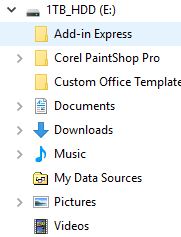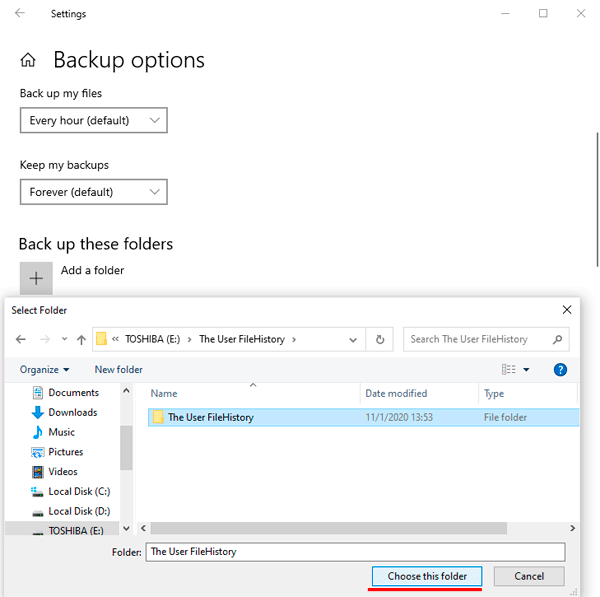

- #File history folder windows 10 how to#
- #File history folder windows 10 install#
- #File history folder windows 10 windows 10#
- #File history folder windows 10 software#
- #File history folder windows 10 Pc#
If you’ve deleted files by mistake, you may be able to retrieve them using third-party software like Shadow Explorer. If you’re only worried about rolling back small changes, however, then Windows’ built-in file history should work well, but you can save versions of files more regularly using tools like AutoVer.
#File history folder windows 10 windows 10#
Restoring previous versions of files in Windows 10 is much easier if you begin using offsite cloud storage, like Google Backup and Sync, to store copies of your files.
#File history folder windows 10 Pc#
Your PC won’t last forever, so it’s important to always have a backup system in mind for Windows. File History only backs up copies of files that are in all folders and subfolders inside your accounts C:UsersThis makes unlimited file versioning, like those offered by AutoVer, a superior solution for long-term backups. While the motive for their deprecation is that. While cloud storage services like Google Drive are alternative options, you’re limited to how often versions of the file can be stored for. Comments (55) (Image credit: Shutterstock) Microsoft is prepping to remove some of its folder options from its Windows File Explorer program. Files are backed up almost immediately, letting you quickly recover changes to files that may have been changed by mistake.

While AutoVer may look a little dated, it works incredibly well in regularly backing up your files and giving you a third-party option for file versioning in Windows 10. Once the software is installed, you can begin to monitor certain folders by selecting the Add New Watcher icon in the AutoVer client.
#File history folder windows 10 install#
To start, download and install AutoVer on your Windows PC.Be cautious when using command-line tools to delete folders. This method bypasses any restrictions or issues that may prevent the file or folder from being deleted. After you set up File History, you can just connect an external drive to your computer and Windows will automatically back up your files to it. Despite the name, File History isn’t just a way to restore previous versions of filesit’s a fully-featured backup tool. While paid options exist, one of the simplest file versioning apps for Windows is AutoVer, a free app that will allow you to regularly back up your files to external drives, network attached storage drives, and offsite FTP servers. Force Delete the Problematic File or Folder Force deleting a problematic file involves using the Command Prompt (or specialized software) to remove a file forcefully. File History is Windows 10’s main backup tool, originally introduced in Windows 8. With that in mind, you may prefer to use third-party file versioning software instead. While it does support network drives, support for this does seem to be more problematic, depending on how your network is configured. Windows File History is a great option for file versioning, but it relies on using an external drive for backups, and backups are limited to every 15 minutes. Using Third Party File Versioning Software You may have more luck if you deleted the file, however, as Microsoft now offers a Windows File Recovery tool to help recover lost files. Recover lost files on Windows 10 - Microsoft Support Products Devices Account & billing More support Recover lost files on Windows 10 Windows Apps Insider Preview If you can’t locate a lost file from your backup, then you can use Windows File Recovery, which is a command line app available from the Microsoft Store. Unfortunately, there aren’t many options to help you restore previous versions in Windows 10 if you don’t already have a backup system in place. This option, as we’ve mentioned, only works if you had File History enabled before you made changes to files. Now you should see the File History window. Using File History and Windows Image Backup are just the tip of the iceberg.Windows File Explorer will open to show you the restored files, whether you selected to overwrite the new copies or save them elsewhere instead. Alternatively, you can click on System and Security and then on File History.
#File history folder windows 10 how to#
How to make create an image backup on Windows 10 and Windows 8.1 We've also created a guide to walk you through each step of that process: If you want to create an image of your drive to use in the event of a complete failure, Windows has a built-in tool that is quite easy to use. If you'd like to take some extra steps and create a network storage solution, have a look at our guide to building your own NAS, or our collection of the best pre-built NAS systems:

If you don't already have an extra hard drive, check out our picks for the best available right now: Your files contained in the backup will now be restored to their original location.


 0 kommentar(er)
0 kommentar(er)
